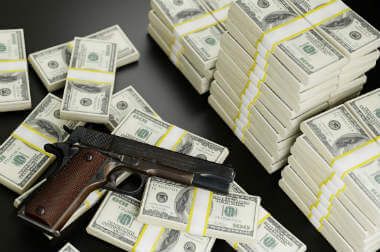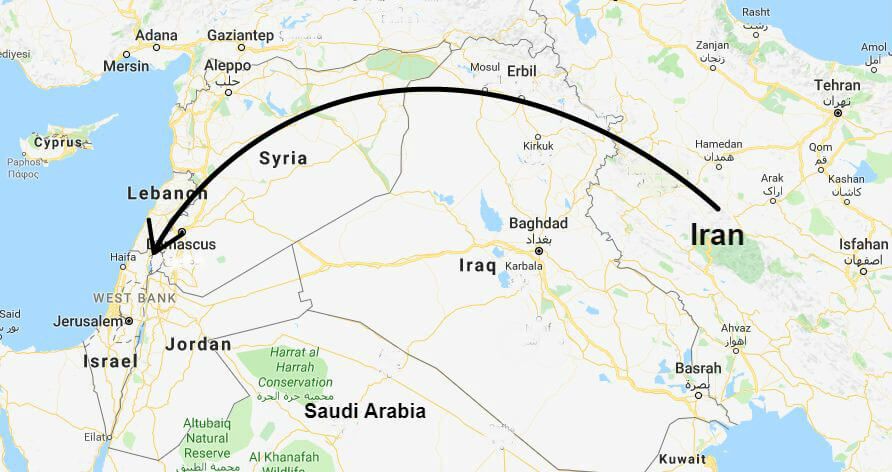No matter what its apologists say, the Hezbollah threat to Israel cannot be minimized or explained away. Since its founding in the 1980s, Hezbollah has amassed a stockpile of rockets larger than all the combined armies of Europe, carried out some of the deadliest terror attacks around the world, and now facilitates Iranian expansionism.
Led by Sheikh Hassan Nasrallah, Hezbollah has also managed to maintain a stranglehold on Lebanese domestic politics.
Join the fight for Israel’s fair coverage in the news
The Hezbollah threat: the origins
Hezbollah was founded in the early 1980s by Lebanese Shiite clerics inspired by the teachings of Ayatollah Ruhollah Khomeini, the radical leader of the Iran’s Islamic revolution. They received crucial assistance from Iran’s Revolutionary Guards and from Syria. Their immediate goals included driving the Israeli military out of a security zone in southern Lebanon and ridding the country of international peacekeepers; their long-term goals included launching a revolutionary Islamic movement in Lebanon and destroying Israel.
Hezbollah put itself on the map with coordinated pair of suicide bombings on the morning of October 23, 1983. The truck bombings of the Beirut barracks of US and French peacekeeping forces killed 241 US servicemen, mostly Marines, 58 French military personnel, and six civilians. Hezbollah’s prominence rose even more when, four months later, the Western peacekeepers withdrew from Lebanon.
Related reading: The 1982 Lebanon War – Operation Peace For the Galilee
The 1990 agreement ending the Lebanese Civil War called for the disarming of all militias. However, thanks to Iranian and Syrian influence, Hezbollah was given an exception to allow it to continue “resisting” Israel.
The Hezbollah threat: Iranian support

Funded by Iran, Hezbollah is an Iranian proxy. Details on Tehran’s support are scant, but Dr. Ali Bakeer explains:
Since its establishment in the early eighties, Hezbollah relied heavily on the money coming from Iran. However, during the last two decades, it has worked hard to diversify the sources of its financial income. This move aimed to give the party considerable flexibility in critical times, and a greater ability to evade efforts targeting its financial ties with Iran. Among other goals too, Hezbollah wanted to ease the burden on Iran and meet the increasing needs of its stretched regional agenda from its own financial sources.
To that end, the Shia party built its own parallel economy inside Lebanon and indulged in economic and financial activities across several continents—from Africa to Latin America to Asia. Its activities as “a transnational criminal organization” mainly include money laundering, construction, and contracting business among others. Today, Hezbollah’s money comes from five main sources: Supreme Leader Ali Khamenei, Iran as a state, its foreign economic empire, the khums (where Shia Muslims pay one-fifth of their excess income to Iranian religious authorities), and the parallel economy inside Lebanon. The annual budget of Hezbollah is unknown, however, most recent estimates indicate that the Iranian support constitutes around 70 percent to 80 percent of Hezbollah’s budget, which is approximately equal to $700 million. This range was never fixed due to lack of transparency and extended agenda of Hezbollah in the last decade.
Related reading: Iran: The Regional Threat Explained
Hezbollah’s military threat
Hezbollah is thought to have an armed force of 45,000 men, many of whom have gained valuable combat and technical experience fighting alongside Russian and Syrian forces in Syria.
But the greater Hezbollah threat is its arsenal of an estimated 150,000 rockets. This includes the precision guided Tishreen missile, and Iranian-made Fajr missiles. Since the 2006 war in Lebanon, Hezbollah has also upgraded its anti-tank, anti-aircraft and anti-ship capabilities.
Iran’s Covert Scheme to Upgrade Hezbollah’s Rocket Arsenal Revealedhttps://t.co/C785TvrTkz pic.twitter.com/O6KiNGJRRi
— Haaretz.com (@haaretzcom) February 28, 2019
In December, 2018, the IDF moved against Hezbollah tunnels penetrating into Israeli territory. By the end of Operation Northern Shield in mid-January, Israeli military engineers uncovered and neutralized six terror tunnels of varying degrees of sophistication and operational readiness.
It is believed that Hezbollah planned to use the tunnels to capture land, take hostages and paralyze responding Israeli forces in the chaos.
Hezbollah forces in Lebanon and Syria also facilitate Iran’s regional expansionism. One of Tehran’s strategic goals is to create a land bridge to the Israeli border via northern Iraq. The movement of personnel and weapons by land is less detectable than by air. Such a land corridor would allow Iran to more directly arm, train and supervise its proxy militias in the Syrian Golan, gather intelligence and disrupt Israeli-Palestinian peace efforts.
Related reading: How Iran’s Land Bridge Threatens the Entire Middle East
A land bridge would also strengthen Iran’s influence over Lebanon; it is thought that Tehran would like to build a naval base on the Mediterranean to more directly challenge Israel.

The Hezbollah terror threat
The Hezbollah threat includes a history of deadly terror attacks on targets around the world. The more notable ones include:
- AMIA bombing (85 killed, hundreds injured in Buenos Aires)
- Israeli embassy in Buenos Aires (29 killed, 242 injured)
- Khobar Towers (19 US airmen killed, more than 350 injured in Saudi Arabia)
- Abducting two IDF soldiers in a cross-border raid, sparking the 2006 Lebanon War.
- The Burgas bombing (six people killed in Bulgaria)
- Alas Chiricanas Flight 901 (all 21 people on board killed over Panama)
Other suicide attacks between between 1982-1986, killed 659 people.
Related reading: Hezbollah and the UN’s Toothless Resolution 1701
Military and political ‘wings’
A number of countries, such as Britain and the Gulf states, have blacklisted Hezbollah as a terror organization. But other countries and international organizations, such as the European Union, have outlawed only the organization’s “military wing” — not its “political wing.”
This approach to countering the Hezbollah threat erroneously assumes that the organization is divided into “wings.” However, Hezbollah leaders themselves have openly stated for years that there is no distinction. Hezbollah’s number two man, Naim Qassem said in 2009:
“All political, social and jihad work is tied to the decisions of this leadership,” he said. “The same leadership that directs the parliamentary and government work also leads jihad actions in the struggle against Israel.”
Indeed, the organization’s highest decision-making body, the Shura Council, is made up of senior figures from across Hezbollah’s various social, political and military institutions. This council makes decisions on all facets of Hezbollah activities — including military operations.
* * *
The Hezbollah threat to Israel is greater than any other Mideast terror group’s, given the arsenal it has amassed, the combat experience it has gained, and the level of support it enjoys from Iran. No conversation about this Hezbollah is complete without a clear-eyed understanding of where it has come from and what it hopes to achieve.
Other Resources
- Israel Defense Forces: Hezbollah: Facts and Figures
- AIPAC: Hezbollah: Mounting Threat to Israel
- CSIS: Hezbollah’s Missiles and Rockets
- BESA Center: The Low-Profile War Between Israel and Hezbollah
- High Level Military Group: Hizballah’s Terror Army: How to Prevent a Third Lebanon War
- JCPA: Lebanon’s Army and Hizbullah Join Ranks
Image of money: CC0 Pixabay;
Before you comment on this article, please note our Comments Policy. Any comments deemed to be in breach of the policy will be removed at the editor’s discretion.

